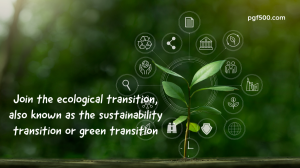The ecological transition, also known as the sustainability transition or green transition, refers to the shift towards a more sustainable and environmentally friendly economy.
It involves adopting practices and technologies that reduce the negative impact on the environment, conserve resources, and promote social responsibility.
.

The ecological transition is crucial for several reasons:
1. Environmental Preservation: The transition is essential for addressing pressing environmental issues such as climate change, deforestation, pollution, and depletion of natural resources. By reducing greenhouse gas emissions, promoting renewable energy, and implementing sustainable practices, we can mitigate the environmental damage and preserve the planet for future generations.
2. Regulatory Framework: Governments worldwide are implementing stricter regulations and policies to encourage sustainable practices and combat environmental degradation. Businesses that fail to comply with these regulations may face penalties, fines, or even legal action. Embracing the ecological transition allows SMEs to stay ahead of regulatory changes and minimize risks associated with non-compliance.
3. Consumer Demand: Consumers are increasingly becoming environmentally conscious and favoring businesses that demonstrate a commitment to sustainability. SMEs that proactively embrace the ecological transition can tap into a growing market of environmentally conscious consumers, gain a competitive advantage, and enhance their brand reputation.
4. Cost Savings: Transitioning to sustainable practices often leads to long-term cost savings. For example, adopting energy-efficient technologies, reducing waste, and optimizing resource consumption can lower operational costs. Additionally, businesses that embrace sustainability may qualify for incentives, grants, or tax benefits provided by governments or sustainable initiatives.
5. Innovation and Market Opportunities: The ecological transition stimulates innovation as businesses seek new ways to reduce their environmental impact. It opens up opportunities for SMEs to develop and provide sustainable products, services, and solutions. Moreover, the transition creates new markets, partnerships, and collaborations among businesses aiming to address sustainability challenges collectively.
6. Risk Mitigation: Businesses that rely heavily on scarce resources or operate in industries vulnerable to climate change-related risks face significant challenges in the long run. By proactively adopting sustainable practices, SMEs can diversify their supply chains, reduce exposure to resource scarcity, and strengthen their resilience to environmental risks.
.
Seizing the time for SMEs is crucial because:
1. Adaptation Period: Transitioning to sustainable practices often requires adjustments in operations, processes, and business models. Implementing these changes takes time, and SMEs need to start early to adapt smoothly. Waiting too long can result in rushed and inefficient transitions, leading to higher costs, operational disruptions, and missed opportunities.
2. Competitive Advantage: By embracing the ecological transition early on, SMEs can gain a competitive edge over rivals. They can differentiate themselves in the market, build a reputation as environmentally responsible businesses, and attract environmentally conscious customers who are increasingly seeking sustainable products and services.
3. Access to Funding and Support: Governments, financial institutions, and various organizations provide funding, grants, and support programs to businesses transitioning to sustainability. However, the availability of these resources may diminish as more businesses seek assistance. Acting early allows SMEs to access a broader range of resources and support, increasing their chances of securing funding and leveraging opportunities.
4. Reputation Building: Building a positive brand image as an environmentally responsible business takes time and consistency. By initiating the ecological transition early, SMEs can establish themselves as sustainability leaders, which enhances their reputation, strengthens customer loyalty, and fosters trust among stakeholders.
5. Learning Curve and Experience: The transition to sustainability requires learning, experimentation, and adaptation. By starting early, SMEs can gain valuable experience, understand the challenges and opportunities, and fine-tune their strategies. This positions them as leaders and experts in sustainable practices, enabling them to guide and mentor others in the future.
.
In conclusion, the ecological transition is a crucial step towards creating a sustainable and resilient economy. SMEs have a unique opportunity to embrace this transition early, allowing them to reap numerous benefits.
By proactively adopting sustainable practices, SMEs can address environmental challenges, comply with regulations, tap into a growing market of environmentally conscious consumers, achieve cost savings, foster innovation, and mitigate risks.
Seizing the time is essential because it allows SMEs to adapt smoothly, gain a competitive advantage, access funding and support, build a positive brand image, and acquire valuable experience.
.
By taking action early, SMEs can position themselves as sustainability leaders and contribute to a greener future while securing their long-term success.
.
Eco-friendly business made simple with pgf500
.





